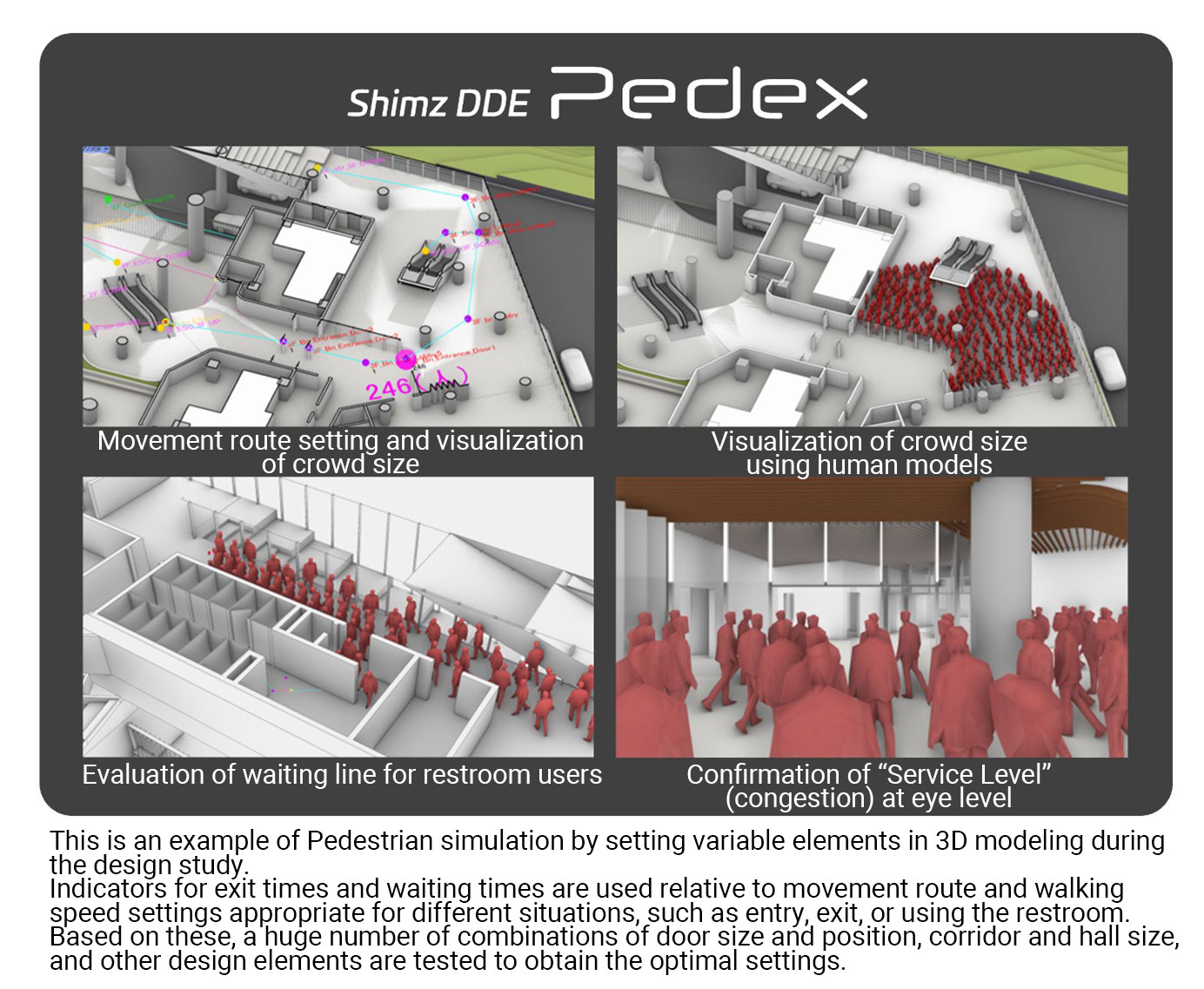September 5, 2024
Shimizu Corporation (President: Kazuyuki Inoue) recently started the development and operation of “Shimz DDE Pedex” and “Shimz DDE Audix”. These systems can evaluate people flow and acoustic performance of various facilities at the same time as the design study. They were developed as engineering tools to achieve more advanced Schematic Design. Conventionally, the Pedestrian flow and Acoustic performance of a facility is evaluated by an expert during the design study. But to improve design proposal capabilities, designers wanted an environment where they could evaluate the performance at the same time in the Preliminary Design stage, when many elements have not yet been determined. The two systems address this demand, providing design process innovation.
The systems share some common features. Firstly, variable elements that affect Pedestrian flow and Acoustics can be set to immediately evaluate their performance. Thousands of patterns in a huge number of combinations can be tested to select the optimal design option in less than a day. Secondly, the systems can provide a wide range of visual outputs. These enable even customers to understand the performance at a glance.
“Shimz DDE Pedex” was developed by Shimizu in collaboration with Vector Research Institute, Inc. and Algorithm Design Lab. Unlike evaluations based on conventional evacuation behavior, the feature of this system is that it evaluates diverse behavior under usual conditions. It can replicate the crowd behavior of tens of thousands of people even during the initial 3D modeling of the design study. For example, the system visualizes evaluations that reflect complex characteristics of crowd behavior. These include visitors who wait for other group members before entering or leaving, people moving around inside the facility, and different ratios of such behavior. The parameters required for the evaluation are the movement purpose, movement route, walking speed, the positions, number, and sizes of doors, the width and length of corridors, and others. Shimizu identified these elements by inspecting many facilities with large spaces for itself. Shimz DDE Pedex has been highly rated for its reliability by Professor Hideaki Takayanagi of the Faculty of Urban Life Studies Department of Urban Life Studies, Tokyo City University. Professor Takayanagi is an expert in Pedestrian flow analysis.
“Shimz DDE Audix” evaluates and visualizes acoustic performance in spaces where many people gather, such as concert halls and theaters. Starting with the evaluation by studying the shape of the space using the early reflections, this is an index for checking whether singing voices and other sounds from the stage can clearly reach the audience. Then, Acoustic evaluation indicators are set, such as the reverberation time, the speech transmission index (as an indicator of speech clarity), and sound pressure distribution that are suitable for spatial applications. Floor, wall, and ceiling shapes and materials (sound absorbing performance) that satisfy these indicators are then studied. This process is repeated to optimize the design. The key point in developing Shimz DDE Audix was the quantification of the quality of the early reflections. This enables evaluations even by non-experts, making it a very practical system.
Both these systems will be provided to internal designers as new tools of Shimz DDE (Digital Design Enhancement platform) for Schematic Design. The reliability of these systems has been verified in multiple design and construction projects. Their evaluations were confirmed to be of equivalent standard to experts. In the future, Shimizu will improve its design proposal capabilities by using these systems to develop facilities with stress-free, smooth Pedestrian flow and pleasant Acoustics from the Preliminary Design stage.
≪For Reference≫
Overview of Shimz DDE Pedex
The target space is modeled as a network by setting entrances, exits, and branch points as nodes and using the connecting routes and corridors as links. Parameters such as the movement purpose, movement route, walking speed, the positions, number, and sizes of doors, and the width and length of corridors are set. These are used to calculate entry and exit times, crowd size, and other information.

Overview of Shimz DDE Audix
This system is based on a 3D model of the finished surfaces of the target space, such as the walls, floor and ceiling. It predicts the propagation of sound within the space by tracking the path of the sound emitted from the source on the stage as it is transmitted and repeatedly reflected. The materials and structure of each finished surface can be selected within the tool. This allows Acoustic performance elements to be set, such as how much sound is absorbed when sound bounces off each surface.

The information contained in this news release is the current information on the date of publication. Please be aware that this information may have changed by the time you view it. Please contact the company to inquire for further details.
